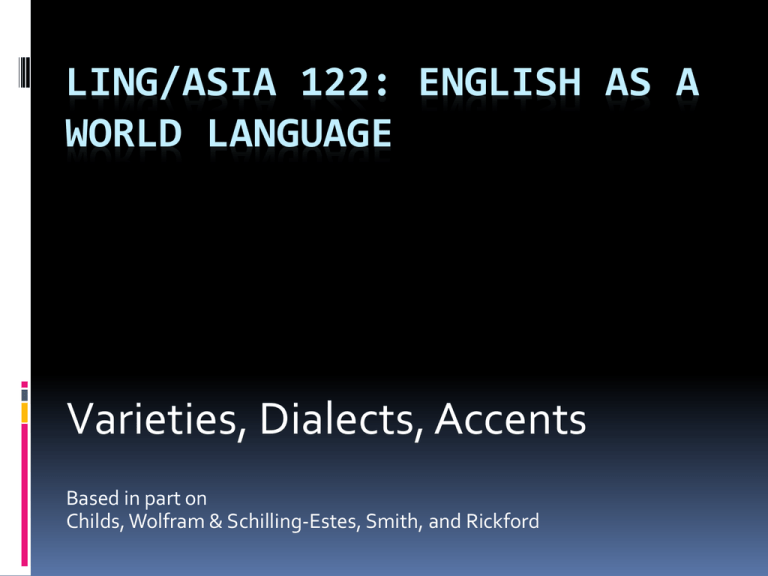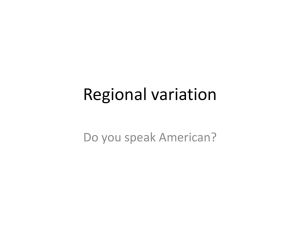Dialects
advertisement

LING/ASIA 122: ENGLISH AS A WORLD LANGUAGE Varieties, Dialects, Accents Based in part on Childs, Wolfram & Schilling-Estes, Smith, and Rickford Who in this room speaks a dialect? Dialects Dialects of American English as YOU see them Dialects of American English Some Popular Senses of “Dialect” ‘We went to Boston for a vacation and the people there sure do speak a dialect.’ ‘Dialect’ here refers simple to those who speak differently from oneself. Some Popular Senses of “Dialect” ‘I know we speak a dialect in the mountains, but it’s a very colorful way of speaking.’ ‘Dialect’ here refers to those varieties of English whose features have become widely recognized through American society, e.g., Southern drawl New York accent Etc. For a variety of historical and social reasons, some dialects have become much more marked than others in American society, and speakers of those varieties therefore accept the dialect label more comfortably. Some Popular Senses of “Dialect” ‘The kids in that neighborhood don’t really speak English; they speak a dialect.’ ‘Dialect’ here is perceived as an imperfect attempt to speak ‘correct’ or ‘proper’ English For example: Three mile Her ears be itching She done grew vs. vs. vs. Three miles Her ears itch She’s grown up Linguists maintain that: ‘Dialect’ is a neutral label to refer to any variety of a language that is shared by a group of speakers. To speak a language is to speak some dialect of that language In this definition, there is no inherently ‘good’ or ‘bad’ dialects ‘Dialect’ is simply how we refer to any language variety that typifies a group of speakers within a language. Socially favored or ‘standard’ varieties constitute dialects every bit as much as those varieties spoken by socially disfavored groups whose language differences are socially stigmatized. Facts about dialects All languages consist of dialects (a language is a group of dialects; to speak a language is to speak a dialect of that language) Therefore, everyone speaks at least one dialect Dialect differences are usually minor and dialects of a language are usually mutually intelligible Dialects are geographically, socially, politically determined Facts about dialects Dialects can vary with respect to: Phonology – pronunciation or the sound system of a language, e.g. r-less dialects of East Coast, pin/pen Morphology – the smallest meaningful units of a language, e.g., ‘He don’t know.’ ‘The house needs painted.’ Syntax – grammar or the words are put together to form sentences, e.g., ‘We prevented the house (from) being destroyed.’ Lexicon – vocabulary or the words of a language (e.g., lift/elevator, truck/lorry, pail/bucket) Facts about dialects Some linguists distinguish between ‘dialect’ and ‘accent’: Different dialects have differences of grammar and vocabulary; Different accents have differences of pronunciation; Every user of English uses one dialect or another, and one accent or another. Facts about dialects The status of any given dialect is arbitrarily determined (‘A language is a dialect with a navy and army’) E.g., Swedish vs. Norwegian But dialects can sometimes be mutually unintelligible E.g., Mandarin vs. Cantonese The terms ‘dialect’ & ‘language’ are politically and socially loaded. Facts about dialects Dialect variation is a matter of difference, not deficit. Nonstandard dialects are “self-contained” systems, with their regular phonological and syntactic rules. Nonstandard dialects of English are close relatives to SE, sometimes reflecting older forms of SE. American Dialects American dialects: How Linguists see them What are the major US dialects that linguists identify? American dialects: How people around the country see them Which dialects do many Americans consider “bad English”? What do the majority of Americans see as the norm? America Dialects: How Hollywood sees them. American Dialects Discussion Do you agree with the findings of Preston’s study that concludes that two of the low-prestige dialects in the U.S. are those spoken in NY and Texas? As you were growing up, what dialects / accents did you make fun of? What were some of its features? Why was it considered funny? Dialect Variation Pragmatics Dialects can also differ with respect to pragmatics The relationship between language and the contexts / situations in which it is used Consider the contexts for these two sentences: “Where are you GOing?” “Where are YOU going?” Dialect Variation: Pragmatics Both have the structure of a wh- question, BUT The first in fact would be typically used as a request for information (e.g. to a person you know is about to leave for a vacation). The second can also be a request for information (e.g. when asking several people in turn where each is going for their vacation). But the second can also be used in another way, to indicate that the person showing signs of leaving should not be going anywhere. What is Standard English? What it is not: An arbitrary, a priori description of English The usage of a particular group The statistically most frequently occurring forms of English A form imposed upon those who use it. Peter Strevens A Working Definition of Standard English A particular dialect of English, being the only non-localized dialect, of global currency without significant variation, universally accepted as the appropriate educational target in teaching English; which may be spoken with an unrestricted choice of accent. Standard English Strevens defines ‘Standard English’ as that dialect of English that is not associated with any particular locality, and therefore occurs in any and every locality. It is not paired with a specific accent. Global Currency for Standard English Those who use Standard English – whether as their mother tongue or as a foreign or second language Are not confined to any single locality or geographical area; May be found in any inhabited region of the world. Universal Acceptance of SE Although SE dialect is universally accepted as the educational target, no single accent fills an equivalent position. The tacit acceptance of SE dialect for educational purposes does not mean that it is ‘best’ in some universal sense. Standard English and Social Class Most, if not all, English users switch between SE and some other dialect. People vary their language according to the social circumstances. Non-conformity to the norms of language use appropriate for the context is often seen as unacceptable behavior. The English Languages? McArthur Will English as an international language succumb to the same fate as Latin? Vulgar Latin evolved into the Romance languages Classical Latin was used for administration and literature and survived in writing. Standard English is more like Classical Latin than Vulgar Latin. SE has a common core negotiated among a a variety of national standard varieties. Dialects, Standards, Vernaculars Wolfram & Schiling-Estes What do we listen to when we listen to people talk? HOW people talk as much or more than to WHAT people say After listening, we usually make judgments about people by the kind of language they use Their regional background Their social status Their ethnicity Their education etc. So there are some who believe that language differences serve as the single most reliable indicator of social position in our society: When we live a certain way, we are expected to match that lifestyle with our talk; When we don’t meet people’s expectations to match that lifestyle with our talk (e.g., a teacher talking like a punk), the mismatch between words and behavior is itself a topic for conversation. Language differences are unavoidable in a society composed of a variety of social groups. Dialectologists’ Position Dialects are not deviant forms of language, but simply different systems with distinct subsets of language patterns. All language varieties are systematic For any language feature, there are contexts in which the form may be used and contexts in which it is not typically used. Appalachian Dialect Patterns 1a. b. 2a. b. 3a. b. 4a. b. 5a. b. Building is hard work. She was building a house. He likes hunting. He went hunting. The child was charming the adults. The child was very charming. He kept shocking the children. The story was shocking. They thought fishing was easy. They were fishing this morning. Further Patterns for Appalachian a1a. They make money by building houses. b. They make money building houses. 2a. You can’t make much money fishing. b. You can’t make much money by fishing. 3a. People destroy the beauty of the mountains through littering. b. People destroy the beauty of the mountains littering. More Patterns for Appalachian a1a. b. 2a. b. 3a. b. 4a. b. She was disCOVering a trail. She was FOLlowing a trai. She was rePEATing the chant. She was HOLlering the chant. They were FIGuring the change. They were forGETting the change. The baby was RECognizing her mother. The baby was WRECKing everything. So what is ‘Formal Standard English’? ‘Formal Standard English’ is a variety (i.e., dialect) of English that Is based on the written language of established writers Has been codified in English grammar texts Is perpetuated in schools Is conservative and resistant to change Then what is ‘Informal Standard English’? Informal Standard English is a variety (i.e., dialect) of English that Exists on a continuum, rather than a categorical notion Is flexible with respect to specific features of regional varieties Employs specific criteria to judge speech as standard Is defined in terms of what it is not Avoidance of socially stigmatized forms, e.g., double negatives – ‘They didn’t do nothing.’ different verb agreement patterns – ‘They’s o.k.’ different irregular verb forms – ‘She done it.’ Continuum of Standardness Standard--A---B---C---D---E—Nonstandard Standard or non-standard? He’s not as smart as I. He’s not so smart as I. He ain’t as smart as me. He not as smart as me. Standard or non-standard? He’s not to do that. He not supposed to do that. He don’t supposed to do that. He’s not supposed to do that. Standard or non-standard? I’m right, ain’t I? I’m right, aren’t I? I’m right, am I not? I’m right, isn’t I? I’m right, isn’t it? Standard or non-standard? A person should not change one’s speech. One should not change one’s speech. A person should not change their speech. A person should not change his or her speech. ‘Vernacular’ Dialects Varieties of language that are not classified as standard dialects Applied to spoken language Exist on a continuum Listener judgment essential in determining social unacceptability Usually characterized by presence of stigmatized structures Not all speakers use the entire set of structures associated with that dialect Labeling Vernacular Dialects Strong affective associations related to particular labels Negro Dialect, Substandard Negro English, Nonstandard Negro English, Black English AfroAmerican English, Ebonics, Vernacular Black English, African American (Vernacular) English, African American Language Latino/a English, Chicano/a English, Hispanic English, Cholo California talk, valley girl, surfer Which do you prefer? Why? Are they the same? What do you call the vernacular you speak? What’s ‘Standard’? What’s a ‘Dialect’? Notice the different definitions of both ‘standard’ and ‘dialect’ found in the readings for this lecture. Can you write a paragraph outlining the differences siting sources read in class?








